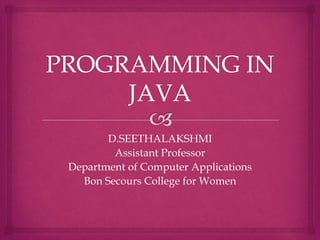
Java Fundamentals Explained in 40 Characters
- 1. D.SEETHALAKSHMI Assistant Professor Department of Computer Applications Bon Secours College for Women
- 2. Java is a high-level general-purpose object-oriented and secure programming language developed by James Gosling at Sun Microsystems Inc. in 1991. It is formally known as OAK. In 1995 Sun Microsystem changed the name to Java. In 2009 Sun Microsystem takeover by Oracle Corporation. What is JAVA?
- 3. Java Standard Editions (JSE): It is used to create programs for a desktop computer. Java Enterprise Edition (JEE): It is used to create large programs that run on the server and manages heavy traffic and complex transactions. Java Micro Edition (JME): It is used to develop applications for small devices such as set-top boxes phone and appliances. Editions of Java
- 4. Standalone Applications: Java standalone applications uses GUI components such as AWT Swing and JavaFX. These components contain buttons list menu scroll panel etc. It is also known as desktop alienations. Enterprise Applications: An application which is distributed in nature is called enterprise applications. Web Applications: An applications that run on the server is called web applications. We use JSP Servlet Spring and Hibernate technologies for creating web applications. Mobile Applications: Java ME is a cross-platform to develop mobile applications which run across smartphones. Java is a platform for App Development in Android. Types of Java Applications
- 5. Java Platform is a collection of programs. It helps to develop and run a program written in the Java programming language. Java Platform includes an execution engine a compiler and set of libraries. Java is a platform-independent language. Java Platform
- 6. There are 3 stages in developing a Java Program: What’s coding – Developing a java program (set of instructions) according to Java syntax or rules is called coding. Java programs should always be saved with a filename.java extension. What’s compilation – Converting the java program into byte codes or .class file using javac compiler is called compilation. Whenever we compile a java program a .class file will be generated and it will have byte codes in it. What’s execution- Converting the byte codes present in the .class file into CPU understandable instructions or binaries using Java Virtual Machine (JVM) which is an interpreter is called execution. Stage of Java
- 8. Simple Robust Portable Platform-independent Secured High Performance Multithreaded Architecture Neutral Object-Oriented Interpreted Dynamic Principles of Java
- 9. The history of Java starts with the Green Team. Java team members (also known as Green Team) initiated this project to develop a language for digital devices such as set-top boxes televisions etc. Java was developed by James Gosling, who is known as the father of Java, in 1995. James Gosling and his team members started the project in the early '90s. History of Java
- 10. 1) James Gosling, Mike Sheridan, and Patrick Naughton initiated the Java language project in June 1991. The small team of sun engineers called Green Team. 2) Initially it was designed for small, embedded systems in electronic appliances like set-top boxes. 3) Firstly, it was called "Greentalk" by James Gosling, and the file extension was .gt. 4) After that, it was called Oak and was developed as a part of the Green project. History of Java
- 11. 5) Why Oak? Oak is a symbol of strength and chosen as a national tree of many countries like the U.S.A., France, Germany, Romania, etc. 6) In 1995, Oak was renamed as "Java" because it was already a trademark by Oak Technologies. Why Java was named as "Oak"?
- 12. Java is an island in Indonesia where the first coffee was produced (called Java coffee). It is a kind of espresso bean. Java name was chosen by James Gosling while having a cup of coffee nearby his office. In 1995, Time magazine called Java one of the Ten Best Products of 1995. Why Java Programming named "Java"?
- 13.
- 16. Object-oriented programming is a way of solving a complex problem by breaking them into a small sub- problem. An object is a real-world entity. It is easier to develop a program by using an object. In OOPs, we create programs using class and object in a structured manner. Class: A class is a template or blueprint or prototype that defines data members and methods of an object. An object is the instance of the class. We can define a class by using the class keyword. Object: An object is a real-world entity that can be identified distinctly. For example, a desk, a circle can be considered as objects. An object has a unique behavior, identity, and state. Data fields with their current values represent the state of an object (also known as its properties or attributes). Object Oriented Programming System
- 17. Abstraction: An abstraction is a method of hiding irrelevant information from the user. For example, the driver only knows how to drive a car; there is no need to know how does the car run. We can make a class abstract by using the keyword abstract. In Java, we use abstract class and interface to achieve abstraction. Encapsulation: An encapsulation is the process of binding data and functions into a single unit. A class is an example of encapsulation. In Java, Java bean is a fully encapsulated class. Inheritance: Inheritance is the mechanism in which one class acquire all the features of another class. We can achieve inheritance by using the extends keyword. It facilitates the reusability of the code. Polymorphism: The polymorphism is the ability to appear in many forms. In other words, single action in different ways. For example, a boy in the classroom behaves like a student, in house behaves like a son. There are two types of polymorphism: run time polymorphism and compile-time polymorphism.